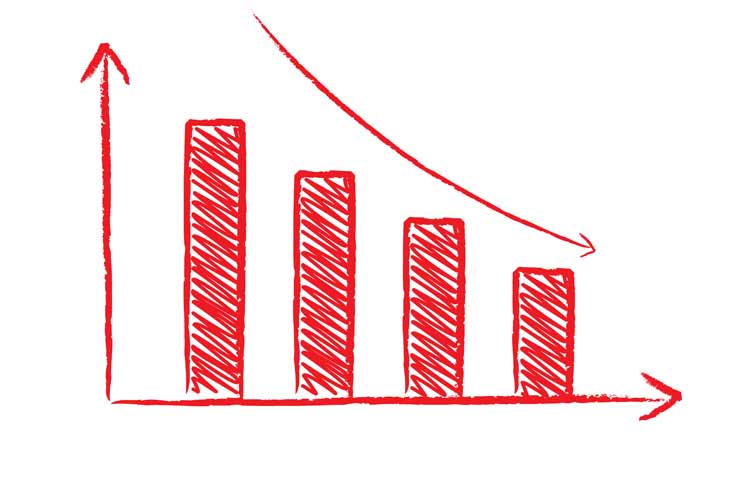
A BofA-Merrill Lynch survey of fund managers suggests stocks haven't been this overvalued in years
After a notable "Trump rally" which sent the major stock market indexes to record highs, the Dow Jones Industrial Average (DJI) suffered its worst day in six months on Tuesday. Likewise, the S&P 500 Index (SPX) also fell, snapping a lengthy streak of more than 100 days without a
1% drop. However, even before yesterday's sell-off, sentiment among stock traders was growing increasingly cautious. Below are four signs the post-election confidence may have peaked.
II Bulls-Minus-Bears Line Breaks Key Level
In last week's
Investors Intelligence (II) sentiment survey, the percentage of self-identified bulls fell to 53.4%, marking the lowest point since just after the election, while those expecting a stock market correction surged to 29.1%, a post-election peak. Meanwhile, the number of self-identified bears edged higher to 17.5%, bringing the bulls-minus-bears line to 35.9% -- below 40% for the first time since early December.
In the latest II poll, the bulls-minus-bears line crept higher to 39.4% -- still beneath the 40% mark we define as "extreme optimism" -- as self-proclaimed bulls rebounded slightly, to 56.7%, while bears dropped back to 17.3%. Those expecting a correction dipped to 26%. Just a few short weeks ago, the percentage of II bulls was at a
30-year high of 63.1%.
AAII Respondents Apathetic
Just a week after self-identified
stock market bears hit an annual high, the latest American Association of Individual Investors (AAII) weekly sentiment poll showed continued apathy. Bearish respondents dropped 7.8 percentage points to 38.7%, as those traders moved to the "neutral" crowd, which saw a 6.6 percentage point jump to 30.1%. AAII bulls edged 1.2 percentage points higher to 31.2%, but the 10-week moving averages of AAII bulls and bears are creeping back toward pre-election levels, per data from Schaeffer's Quantitative Analyst Chris Prybal.

Still, AAII bulls haven't topped 50% since January 2015 -- 115 weeks, which is a record (going back to 1987). In the aftermath of the previous
record streak, stock returns were very strong, hinting at the merits of a contrarian trading approach. Specifically, following the 110-week streak from January 1993 through February 1995, the SPX went on to add 14.4% in the ensuing six months. Going out one year, the broad-market index was up an astounding 35.3%.
NAAIM Suffers Biggest Two-Week Drop Since May
The National Association of Active Investment Managers (NAAIM) exposure index fell to 80.77% last week, its lowest point since the election. The index stood at 102.07% in early March -- the second-highest reading ever -- and its subsequent two-week decline of 21.3% marks the biggest such drop since mid-May.

As Schaeffer's Senior V.P. of Research Todd Salamone noted in this week's
Monday Morning Outlook, "The 10-week moving average of the average long position among these active managers is rolling over from an extreme high ... previous rollovers from extreme highs have preceded corrective periods for stocks. However, there have been instances in which the market's momentum continued, despite extreme optimism receding among the active manager group."

Survey: Stocks Most Overvalued In At Least 17 Years
Meanwhile, the latest fund manager survey from BofA-Merrill Lynch indicates that more than one in three respondents thinks
stocks are overvalued. At 34%, that's the highest level in the history of the survey, which started in 2000. Digging deeper, a whopping 81% of those think the U.S. stock market is the most overvalued, relative to the rest of the world, with
U.S. dollar positions the "most overcrowded."
4 Stages of Sentiment
In conclusion, there are four stages of sentiment: despair, disbelief, acceptance, and euphoria. Market bottoms and tops typically happen when sentiment reaches an extreme, and
SPX returns are typically highest when positive price action is accompanied by disbelief or skepticism.
Those hesitant to get into a long trade or who are concerned about a correction may want to manage risk with the "
stock replacement" options strategy, as Salamone has recommended recently. This strategy consists of trading stock ownership for in-the-money call options, allowing traders to enjoy additional upside without putting everything on the line. In addition, Salamone remains "bullish on gold, and I also think bonds, via the iShares 20+ Year Treasury Bond ETF (TLT), offer decent reward vs. risk over the next month."
Don't miss Schaeffer's free weekly stock market forecast. Sign up now for Monday Morning Outlook.